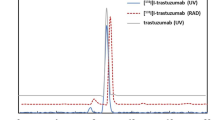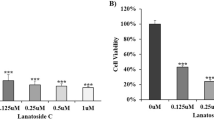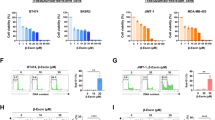Abstract
Purpose
The development of radioimmunotherapy has provided an impressive alternative approach in improving trastuzumab therapy. However, the mechanisms of trastuzumab and radiation treatment combined to increase therapeutic efficacy are poorly understood. Here, we try to examine the efficacy of cytotoxicity and apoptosis induction for 188Re-HYNIC-trastuzumab in cancer cell lines with various levels of Her2.
Materials and methods
Fluorescence flow cytometry was used to detect the alterations of apoptosis induction after 188Re-HYNIC-trastuzumab treatment in two breast cancer cell lines with different levels of HER2 (BT-474 and MCF-7) and a colorectal carcinoma cell line (HT-29) for control.
Results
Our results indicated that 188Re-HYNIC-trastuzumab led to cell death of breast cancer cells specifically in HER2 level-dependent and radioactivity dose-dependent fashions. In BT-474 cells, 370 kBq/ml of 188Re-HYNIC-trastuzumab enhanced the cytotoxicity to a level nearly 100-fold that of trastuzumab-alone treatment. The results also revealed that the mitochondria-dependent pathway attenuated irradiation-induced apoptosis in HER2-expressing breast cancer cells after 188Re-HYNIC-trastuzumab treatment. In contrast, only after 48 h of 188Re-HYNIC-trastuzumab treatment, BT-474 cells exhibited typical apoptotic changes, including exposure of phospholipid phosphatidylserine on the cell surface, or fragmented DNA formation, in a radioactivity dose-dependent manner.
Conclusion
Briefly, our study demonstrates that 188Re-labeled HYNIC-trastuzumab not only enhances cell death in a radioactivity dose-dependent fashion, but may also prolong the effects of apoptosis involved with the mitochondria-dependent pathway in HER2-overexpressing breast cancer cells. It is possible that the 188Re-HYNIC-trastuzumab treatment induced a second round of apoptosis to prolong the effects of cell kill in these cancer cells. These data revealed that 188Re-HYNIC-trastuzumab has the potential for use as a therapeutic radiopharmaceutical agent in HER2-overexpressing breast cancer cell treatment.





Similar content being viewed by others
References
International Agency for research on cancer WHO. “World Cancer Report” (2003).
Anderson BO, Distelhorst SR. Guidelines for international breast health and cancer control-implementation. Introduction. Cancer. 2008;113(8 Suppl):2215–6.
Anderson BO, Jakesz R. Breast cancer issues in developing countries: an overview of the Breast Health Global Initiative. World J Surg. 2008;32(12):2578–85.
Menard S, Tagliabue E, Campiglio M, Pupa SM. Role of HER2 gene overexpression in breast carcinoma. J Cell Physiol. 2000;182(2):150–62.
Slamon DJ, Clark GM, Wong SG, Levin WJ, Ullrich A, McGuire WL. Human breast cancer: correlation of relapse and survival with amplification of the HER-2/neu oncogene. Science. 1987;235(4785):177–82.
Pauletti G, Dandekar S, Rong H, Ramos L, Peng H, Seshadri R, Slamon DJ. Assessment of methods for tissue-based detection of the HER-2/neu alteration in human breast cancer: a direct comparison of fluorescence in situ hybridization and immunohistochemistry. J Clin Oncol. 2000;18(21):3651–64.
Song YJ, Qu CF, Rizvi SM, Li Y, Robertson G, Raja C, Morgenstern A, Apostolidis C, Perkins AC, Allen BJ. Cytotoxicity of PAI2, C595 and Herceptin vectors labeled with the alpha-emitting radioisotope Bismuth-213 for ovarian cancer cell monolayers and clusters. Cancer Lett. 2006;234(2):176–83.
Liang K, Lu Y, Jin W, Ang KK, Milas L, Fan Z. Sensitization of breast cancer cells to radiation by trastuzumab. Mol Cancer Ther. 2003;2(11):1113–20.
Hudis CA. Trastuzumab—mechanism of action and use in clinical practice. N Engl J Med. 2007;357(1):39–51.
Santin AD, Bellone S, Roman JJ, McKenney JK, Pecorelli S. Trastuzumab treatment in patients with advanced or recurrent endometrial carcinoma overexpressing HER2/neu. Int J Gynaecol Obstet. 2008;102(2):128–31.
Fulda S. Tumor resistance to apoptosis. Int J Cancer. 2009;124(3):511–5.
Milella M, Trisciuoglio D, Bruno T, Ciuffreda L, Mottolese M, Cianciulli A, et al. Trastuzumab down-regulates Bcl-2 expression and potentiates apoptosis induction by Bcl-2/Bcl-XL bispecific antisense oligonucleotides in HER-2 gene-amplified breast cancer cells. Clin Cancer Res. 2004;10(22):7747–56.
Boerman OC, Koppe MJ, Postema EJ, Corstens FH, Oyen WJ. Radionuclide therapy of cancer with radiolabeled antibodies. Anticancer Agents Med Chem. 2007;7(3):335–43.
Li G, Wang Y, Huang K, Zhang H, Peng W, Zhang C. The experimental study on the radioimmunotherapy of the nasopharyngeal carcinoma overexpressing HER2/neu in nude mice model with intratumoral injection of 188Re-herceptin. Nucl Med Biol. 2005;32(1):59–65.
Zhang DY, Li Y, Rizvi SM, Qu C, Kearsley J, Allen BJ. Cytotoxicity of breast cancer cells overexpressing HER2/neu by 213Bi-Herceptin radioimmunoconjugate. Cancer Lett. 2005;218(2):181–90.
Li GP, Zhang YF, Wang YX. 188Re-labeled herceptin inhibits proliferation of breast cancer cell line SKBR-3 in vitro. Nan Fang Yi Ke Da Xue Xue Bao. 2006;26(10):1455–7.
Costantini DL, Bateman K, McLarty K, Vallis KA, Reilly RM. Trastuzumab-resistant breast cancer cells remain sensitive to the auger electron-emitting radiotherapeutic agent 111In-NLS-trastuzumab and are radiosensitized by methotrexate. J Nucl Med. 2008;49(9):1498–505.
Chen KT, Lee TW, Lo JM. In vivo examination of (188)Re(I)-tricarbonyl-labeled trastuzumab to target HER2-overexpressing breast cancer. Nucl Med Biol. 2009;36(4):355–61.
Luo TY, Tang IC, Wu YL, Hsu KL, Liu SW, Kung HC, et al. Evaluating the potential of 188Re-SOCTA-trastuzumab as a new radioimmunoagent for breast cancer treatment. Nucl Med Biol. 2009;36(1):81–8.
Li L, Story M, Legerski RJ. Cellular responses to ionizing radiation damage. Int J Radiat Oncol Biol Phys. 2001;49(4):1157–62.
Friesen C, Lubatschofski A, Kotzerke J, Buchmann I, Reske SN, Debatin KM. Beta-irradiation used for systemic radioimmunotherapy induces apoptosis and activates apoptosis pathways in leukaemia cells. Eur J Nucl Med Mol Imaging. 2003;30(9):1251–61.
Blankenberg FG. Imaging the molecular signatures of apoptosis and injury with radiolabeled annexin V. Proc Am Thorac Soc. 2009;6(5):469–76.
Tang Y, Scollard D, Chen P, Wang J, Holloway C, Reilly RM. Imaging of HER2/neu expression in BT-474 human breast cancer xenografts in athymic mice using [(99m)Tc]-HYNIC-trastuzumab (Herceptin) Fab fragments. Nucl Med Commun. 2005;26(5):427–32.
Abrams MJ, Juweid M, tenKate CI, Schwartz DA, Hauser MM, Gaul FE, et al. Technetium-99m-human polyclonal IgG radiolabeled via the hydrazino nicotinamide derivative for imaging focal sites of infection in rats. J Nucl Med. 1990;31(12):2022–8.
Lindmo T, Boven E, Cuttitta F, Fedorko J, Bunn PA Jr. Determination of the immunoreactive fraction of radiolabeled monoclonal antibodies by linear extrapolation to binding at infinite antigen excess. J Immunol Methods. 1984;72(1):77–89.
Carlsson J, Nordgren H, Sjostrom J, Wester K, Villman K, Bengtsson NO, et al. HER2 expression in breast cancer primary tumours and corresponding metastases. Original data and literature review. Br J Cancer. 2004;90(12):2344–8.
Simeone AM, Broemeling LD, Rosenblum J, Tari AM. HER2/neu reduces the apoptotic effects of N-(4-hydroxyphenyl)retinamide (4-HPR) in breast cancer cells by decreasing nitric oxide production. Oncogene. 2003;22(43):6739–47.
Sharkey RM, Goldenberg DM. Targeted therapy of cancer: new prospects for antibodies and immunoconjugates. CA Cancer J Clin. 2006;56(4):226–43.
Tan AR, Swain SM. Ongoing adjuvant trials with trastuzumab in breast cancer. Semin Oncol. 2003;30(5 Suppl 16):54–64.
Friesen C, Glatting G, Koop B, Schwarz K, Morgenstern A, Apostolidis C, et al. Breaking chemoresistance and radioresistance with [213Bi]anti-CD45 antibodies in leukemia cells. Cancer Res. 2007;67(5):1950–8.
Eriksson D, Blomberg J, Lindgren T, Lofroth PO, Johansson L, Riklund K, et al. Iodine-131 induces mitotic catastrophes and activates apoptotic pathways in HeLa Hep2 cells. Cancer Biother Radiopharm. 2008;23(5):541–9.
Friesen C, Lubatschofski A, Glatting G, Debatin KM, Reske SN. Activation of intrinsic apoptotic pathway by Re-188 irradiation and paclitaxel in coronary artery smooth muscle cells. Q J Nucl Med Mol Imaging. 2008;52(3):289–95.
Mirzaie-Joniani H, Eriksson D, Sheikholvaezin A, Johansson A, Lofroth PO, Johansson L, Stigbrand T. Apoptosis induced by low-dose and low-dose-rate radiation. Cancer. 2002;94(4 Suppl):1210–4.
Eriksson D, Joniani HM, Sheikholvaezin A, Lofroth PO, Johansson L, Riklund Ahlstrom K, et al. Combined low dose radio- and radioimmunotherapy of experimental HeLa Hep 2 tumours. Eur J Nucl Med Mol Imaging. 2003;30(6):895–906.
Author information
Authors and Affiliations
Corresponding authors
Rights and permissions
About this article
Cite this article
Luo, TY., Cheng, PC., Chiang, PF. et al. 188Re-HYNIC-trastuzumab enhances the effect of apoptosis induced by trastuzumab in HER2-overexpressing breast cancer cells. Ann Nucl Med 29, 52–62 (2015). https://doi.org/10.1007/s12149-014-0908-8
Received:
Accepted:
Published:
Issue Date:
DOI: https://doi.org/10.1007/s12149-014-0908-8




